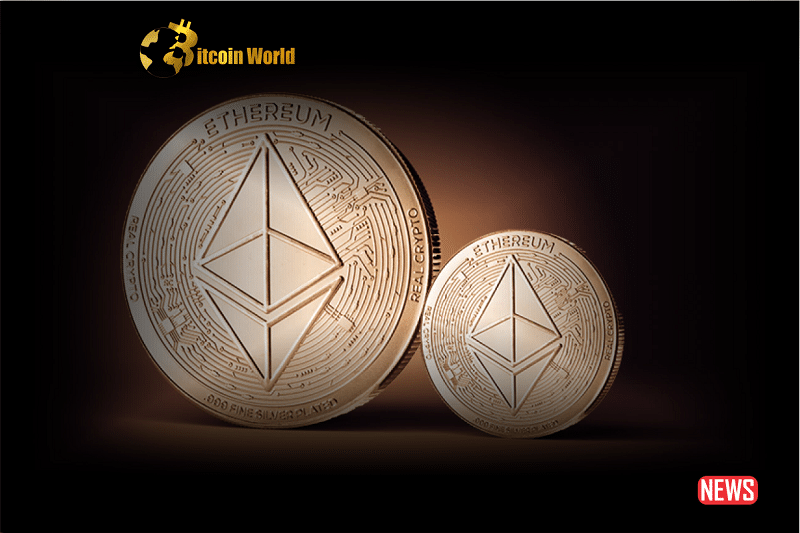Ever wondered where all the Ethereum is going? If you’ve been keeping an eye on the crypto markets, you might have noticed a fascinating trend: the amount of Ethereum (ETH) sitting on cryptocurrency exchanges is shrinking. Recent data from Glassnode Alerts has confirmed what many suspected – ETH balances on these platforms have hit their lowest point in five years. Let’s dive into what’s driving this ‘Ethereum exodus’ and what it means for the broader crypto landscape.
The Numbers Don’t Lie: A Deep Dive into Declining Exchange Balances
The latest insights from Glassnode paint a clear picture. Currently, around 17.2 million ETH are held on exchanges. To put that into perspective, just a few months ago, in January, that figure was north of 19 million. Even in May, it was above 18 million. This consistent downward trend signals a significant decrease in the readily available Ethereum for trading on these platforms – a concept we call liquidity.
| Month | Approximate ETH Balance on Exchanges |
|---|---|
| Current | 17.2 Million |
| May | Over 18 Million |
| January | Over 19 Million |
So, what’s causing this drain? Is everyone suddenly selling their ETH? Not quite!
More Holders, Less on Exchanges: A Curious Case
Here’s the interesting twist: while the ETH on exchanges is decreasing, the number of people holding Ethereum is actually going up! Data from Santiment shows a steady climb in the number of ETH holders, currently hovering around a whopping 100 million. Back in April, that number was closer to 98.4 million. This divergence between decreasing exchange balances and increasing holder numbers points to a shift in how people are managing their Ethereum.
Where’s the ETH Going? Unpacking the Key Drivers
So, if the ETH isn’t on exchanges, where is it? Two main factors are at play:
- Taking Control: The Rise of Self-Custody: Imagine having complete control over your digital assets, like keeping your cash in your own wallet rather than a bank. That’s the appeal of self-custody. More and more Ethereum holders are choosing to move their ETH off exchanges and into their own personal wallets. This gives them greater security and control, reducing the risk of exchange hacks or platform-specific issues.
- Earning Rewards: The Allure of Staking: Ethereum’s transition to a proof-of-stake system has introduced the concept of staking. Think of it like earning interest on your crypto. By locking up a certain amount of ETH, holders can participate in securing the network and earn rewards in the form of more ETH. This incentivizes long-term holding and removes ETH from the readily available supply on exchanges. Currently, over 780,000 ETH deposits are locked up for staking, and this number is constantly growing.
What Does This Mean for the Ethereum Ecosystem?
Despite the shrinking ETH supply on exchanges, the Ethereum ecosystem is far from shrinking. In fact, it’s thriving!
Ethereum’s Dominance in DeFi Remains Strong
Data from DefiLlama reveals that Ethereum continues to be the king of Decentralized Finance (DeFi). The Total Value Locked (TVL) in Ethereum-based DeFi protocols sits at an impressive $27.35 billion, accounting for over half of the total TVL across all blockchains. This massive influx of value highlights the continued importance and utility of Ethereum within the crypto space.
Trading Volume and Market Cap: Still a Heavyweight
CoinMarketCap data confirms Ethereum’s position as the second-largest cryptocurrency by market capitalization, right behind Bitcoin. Even with the reduced exchange balances, ETH boasts significant trading activity. In the last 24 hours, it recorded the third-highest trading volume, contributing over $3 billion to the total cryptocurrency market’s volume, which exceeded $19 billion. This demonstrates strong demand and activity despite the reduced readily available supply on exchanges.
Current Market Snapshot
As of now, Ethereum is trading around the $1,900 mark, solidifying its position as a leading digital asset. This price point, combined with the robust DeFi ecosystem and strong trading volume, paints a picture of a healthy and active network.
Key Takeaways: What You Need to Know
- Decreasing Liquidity: The amount of ETH on exchanges is at a five-year low, indicating reduced immediate liquidity.
- More Holders, Less on Exchanges: The number of Ethereum holders is increasing even as exchange balances decrease.
- Self-Custody is Trending: More users are opting to hold their ETH in personal wallets for greater control and security.
- Staking is Gaining Traction: The opportunity to earn rewards through staking is incentivizing long-term holding off exchanges.
- Ethereum’s Ecosystem Remains Robust: Despite lower exchange balances, Ethereum’s DeFi dominance and trading volume remain strong.
Looking Ahead: What Does This Mean for You?
The trend of decreasing Ethereum balances on exchanges, coupled with the rise of self-custody and staking, signals a maturing cryptocurrency market. Here are a few things to consider:
- For Traders: Lower exchange balances might lead to increased price volatility due to reduced readily available supply.
- For Long-Term Holders: The shift towards self-custody and staking emphasizes the importance of secure wallet management and understanding staking mechanisms.
- For the Ethereum Network: Increased staking contributes to the network’s security and stability.
In Conclusion: A Sign of a Maturing Market
The recent decline in Ethereum balances on exchanges isn’t necessarily a cause for alarm. Instead, it reflects a growing trend towards self-custody and the increasing popularity of staking. While the readily available liquidity on exchanges may be decreasing, the fundamental strength and activity within the Ethereum ecosystem remain undeniable. This ‘Ethereum exodus’ is a compelling indicator of a maturing market where users are taking greater control of their assets and actively participating in the network’s growth and security. It highlights the evolving dynamics of the crypto space and the increasing sophistication of its participants.
Disclaimer: The information provided is not trading advice, Bitcoinworld.co.in holds no liability for any investments made based on the information provided on this page. We strongly recommend independent research and/or consultation with a qualified professional before making any investment decisions.


